Accepted Scientific Name: Gymnocalycium marsoneri Y.Itô
Explan. Diagr. Austroechinocactinae 293 (1957) Y.Itô
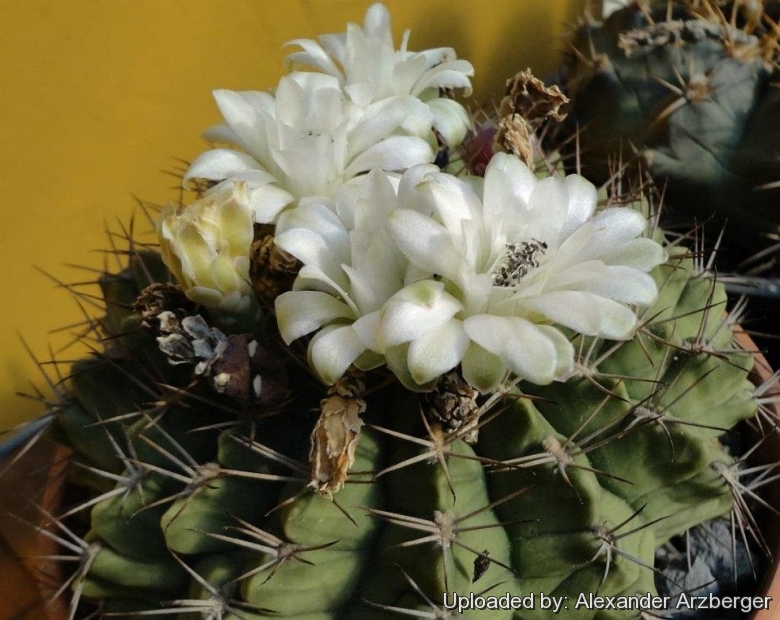
Gymnocalycium marsoneri subs. megatae Photo by: Alexander Arzberger
Origin and Habitat: Gymnocalycium megataeSN|13341]]SN|13341]] (Gymnocalycium marsoneriSN|13338]]SN|13338]] subs. megatae) inhabits a belt of territory, extending between Charagua-Boyuibe-Palos Blancos in the Bolivian Chaco, and crossing the Chaco Boreal (i.e. the departments of Boquerón and Alto Paraguay in Paraguay, where there are still populations of the taxon), it arrived in the area of Porto Murtinho, Mato Grosso do Sul (Brazil) where the Chaco becomes Pantanal.
Habitat and ecology: Gymnocalycium megataeSN|13341]]SN|13341]] forms large colonies in dry areas near salt lakes, but is also found in moister conditions in step cliff faces and is adapted to grow in deep shade. The soil must rapidly crumble away, but these cacti are able to germinate and grow to flowering size before their home falls out from under them. Abundant mosses, normally good indicators of a habitat unsuitable to cacti, least of all healthy cacti, are growing alongside specimens of G. megatae.
Synonyms:
See all synonyms of Gymnocalycium marsoneri
back
Accepted name in llifle Database:Gymnocalycium marsoneri Y.ItôExplan. Diagr. Austroechinocactinae 293 (1957)Synonymy: 12
Accepted name in llifle Database:Gymnocalycium marsoneri subs. matoense (Buining & Bredero) P.J.Braun & EstevesSucculenta (Netherlands) 74: 131. 1995Synonymy: 4
Cultivars
(1):
back
Description: Doubtfully distinct from Gymnocalycium marsoneriSN|13341]]SN|13338]], Gymnocalycium megataeSN|13343]]SN|13341]] (syn: Gymnocalycium marsoneriSN|13328]]SN|13338]] subs. megatae) is a member of a complex group of species, that may include Gymnocalycium tudaeSN|11935]]SN|13346]] and Gymnocalycium onychacanthumSN|13345]]SN|13345]] which inhabit the Gran Chaco of Paraguay and neighbouring areas, and are now considered as mere synonyms. Gymnocalycium eytianumSN|13346]]SN|11935]] and Gymnocalycium pseudomalacocarpusSN|13338]]SN|13328]] are also considered close to this species. Unlike to G. marsoneri that has large rounded tubercles, G. megatae has a large flattened body with acute ribs (characteristic that relate it to Gymnocalycium matoenseSN|13341]]SN|13343]] that grows at the edge of the area to the east of the populations of G. megatae).
G. megatae has 5 thin spines spreading from the body, while G. marsoneri has stouter spines enlarged at the base which are bent toward the body of the plants. However, G. megatae and G. marsoneri are quite different and easily told apart at a glance, and perhaps it may be worth to consider them as two separated species. Gymnocalycium megataeSN|13338]]SN|13341]] freely-produces white flowers.
Stems: Flattened to globular (occasionally up to 30 tall), depressed at the apex 16-20 cm in diameter. Solitary or few branched in age, dull grey-green, often reddish-brown.
Ribs: Acute, strongly marked, divided into polygonal-chinned tubercles, separated by furrows.
Spines: 5 (occasionally up to 9), thin, slightly recurved, pale to dull brown.
Flowers: White to dirty white.
Subspecies, varieties, forms and cultivars of plants belonging to the Gymnocalycium marsoneri group
 Gymnocalycium marsoneri Y.Itô: Widespread and variable. Distribution: Gran Chaco region of northern Argentina and southern Bolivia, Mato Grosso, Plateau of Brazil, and in Paraguay.
Gymnocalycium marsoneri Y.Itô: Widespread and variable. Distribution: Gran Chaco region of northern Argentina and southern Bolivia, Mato Grosso, Plateau of Brazil, and in Paraguay. Gymnocalycium marsoneri subs. matoense (Buining & Bredero) P.J.Braun & Esteves: has about 21 ribs and bluish green fruits. This is the Brazilian population of G. marsoneri. Distribution: Mato Grosso do Sul, border area to Uruguay.
Gymnocalycium marsoneri subs. matoense (Buining & Bredero) P.J.Braun & Esteves: has about 21 ribs and bluish green fruits. This is the Brazilian population of G. marsoneri. Distribution: Mato Grosso do Sul, border area to Uruguay. Gymnocalycium marsoneri subs. matoense cv. Multiproliferum hort.: this is a mutant that produces many suckers from the base and sides. Ribs 8-9 bright green; spines 4-7, thinner, bristle-like, yellowish-white or brownish, later grey.
Gymnocalycium marsoneri subs. matoense cv. Multiproliferum hort.: this is a mutant that produces many suckers from the base and sides. Ribs 8-9 bright green; spines 4-7, thinner, bristle-like, yellowish-white or brownish, later grey. Gymnocalycium marsoneri subs. megatae (Y.Itô) G.J.Charles: has a large flattened body with acute ribs, and 5 thin spines spreading from the body. Distribution: Bolivian Chaco, and Chaco Boreal (Paraguay), to Porto Murtinho, Mato Grosso do Sul (Brazil) where the Chaco becomes Pantanal.
Gymnocalycium marsoneri subs. megatae (Y.Itô) G.J.Charles: has a large flattened body with acute ribs, and 5 thin spines spreading from the body. Distribution: Bolivian Chaco, and Chaco Boreal (Paraguay), to Porto Murtinho, Mato Grosso do Sul (Brazil) where the Chaco becomes Pantanal.
Bibliography: Major references and further lectures
1) Gymnocalycium megatae in: The Cactus and Succulent Journal of Great Britain, Cactus and Succulent Society of Great Britain, 1977
2) Gymnocalycium megatae in: The Cactus and Succulent Journal of Great Britain, Cactus and Succulent Society of Great Britain, 1982
3) Pilbeam “Gymnocalycium - A collector's guide”. 1995
4) Charles, G. “Gymnocalycium in habitat and culture”. Stamford, England: published by the author. 2009.
5) Braun, P. J. & Esteves Pereira, E. “Kakteen und andere Sukkulenten in Brasilien.” Schumannia 3: 1-235. 2001.
6) Anceschi, G. & Magli, A. “South America 2005/2010.” Bologna. MODO infoshop.2010.
7) James D. Mauseth, Roberto Kiesling, and Carlos Ostolaza “A cactus odyssey: journeys in the wilds of Bolivia, Peru, and Argentina” Timber Press, 2002
8) Joël Lodé. “Cactacées Gymnocalycium megatae Y.Ito” Collections: Herman Schwatzz, USA. Edisud. Aix. Série 5 <https://www.cactuspro.com/biblio_fichiers/pdf/Lode/LodeC-Floribunda-Myrtillocactus_O.pdf>
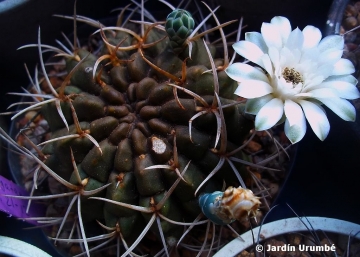 Gymnocalycium marsoneri subs. megatae Photo by: Alexander Arzberger
Gymnocalycium marsoneri subs. megatae Photo by: Alexander Arzberger Gymnocalycium marsoneri subs. megatae Photo by: Alexander Arzberger
Gymnocalycium marsoneri subs. megatae Photo by: Alexander Arzberger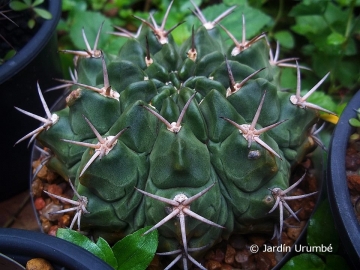 Gymnocalycium marsoneri subs. megatae Photo by: Alexander Arzberger
Gymnocalycium marsoneri subs. megatae Photo by: Alexander Arzberger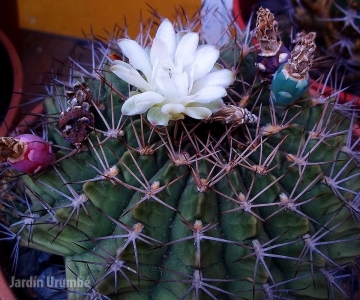 Gymnocalycium marsoneri subs. megatae Photo by: Alexander Arzberger
Gymnocalycium marsoneri subs. megatae Photo by: Alexander Arzberger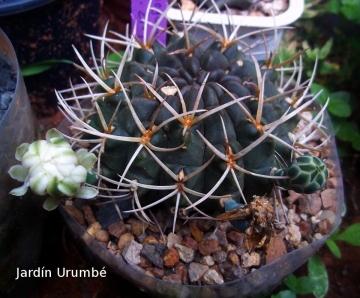 This species flowers laterally from stems sides. Photo by: Alexander Arzberger
This species flowers laterally from stems sides. Photo by: Alexander Arzberger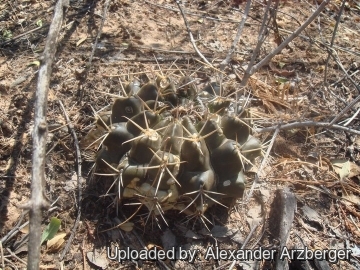 Gymnocalycium megatae, AA 222, Col. Neuland, Dep. Boquerón, Paraguay, 141m. Photo by: Alexander Arzberger
Gymnocalycium megatae, AA 222, Col. Neuland, Dep. Boquerón, Paraguay, 141m. Photo by: Alexander Arzberger Gymnocalycium megatae, AA 270, E Boyuibe, Dep. Sta. Cruz, Bolivia, 762m. Photo by: Alexander Arzberger
Gymnocalycium megatae, AA 270, E Boyuibe, Dep. Sta. Cruz, Bolivia, 762m. Photo by: Alexander Arzberger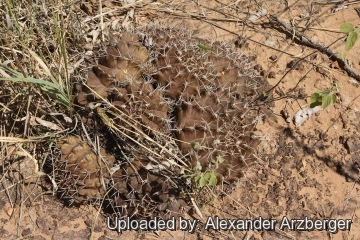 Gymnocalycium marsoneri subs. megatae Photo by: Alexander Arzberger
Gymnocalycium marsoneri subs. megatae Photo by: Alexander ArzbergerCultivation and Propagation: Gymnocalycium megataeSN|13341]]SN|13341]] is a summer grower species that is easy to cultivate.
Growth rate: It is a relatively rapidly growing and easily flowering species that will make clumps given the best conditions.
Soils: It likes very porous standard cactus mix soil. Prefer a low pH compost, avoid substrata rich in limestone; otherwise growth will stop altogether.
Repotting: This plant needs plenty of space for its roots, repotting should be done every other year or when the it has outgrown its pot. Use pot with good drainage.
Watering: Needs moderate to copious waterings in summer, but do not overwater (Rot prone), keep dry in winter at a minimum temperature of 0°C.
Fertilization: Feed with a high potassium fertilizer in summer.
Hardiness: Reputedly resistant to frost if kept on the dry side prior to, and during, cold weather (hardy to -5 C ° C, or less for short periods).
Exposition: The plant tolerates extremely bright situations but enjoys filtered sunlight or afternoon shade, inside it needs bright light, and some direct sun. Tends to bronze in strong light, which encourages flowering and heavy spine production, but is likely to suffer from sun scorch or stunted growth if over exposed to direct sunlight during the hottest part of the day in summer.
Uses: It is an excellent plant for container growing. It always looks good and stays small. It look fine in a cold greenhouse and frame or outdoor in a rockery.
Pests & diseases: It may be attractive to a variety of insects, but plants in good condition should be nearly pest-free, particularly if they are grown in a mineral potting-mix, with good exposure and ventilation. Nonetheless, there are several pests to watch for:
- Red spiders: Red spiders may be effectively rubbed up by watering the plants from above.
- Mealy bugs: Mealy bugs occasionally develop aerial into the new growth among the wool with disfiguring results, but the worst types develop underground on the roots and are invisible except by their effects.
- Scales: Scales are rarely a problem.
- Rot: This species is particularly easy and accommodating, seldom suffer of cryptogamic diseases. Rot it is only a minor problem with gymnocalyciums if the plants are watered and “aired” correctly. If they are not, fungicides won't help all that much.
Propagation: Division, direct sow after last frost. Seeds germinate in 7-14 days at 21-27° C in spring, remove gradually the glass cover as soon the plants will be well rooted (ca 1-2 weeks) and keep ventilated, no full sun for young plants! To make a cutting twist off a branch and permit it to dry out a couple of weeks, lay it on the soil and insert the stem end partially into the soil. Try to keep the cutting somewhat upright so that the roots are able to grow downward.
Your Photos

by Alexander Arzberger

by Alexander Arzberger





















